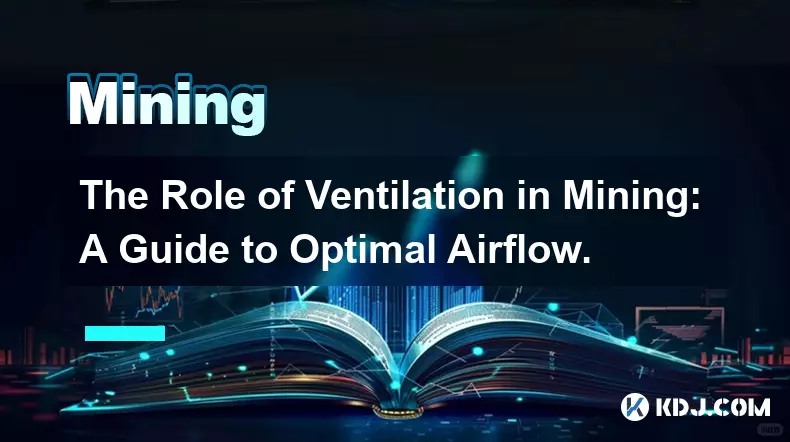-
 bitcoin
bitcoin $100977.009184 USD
-2.05% -
 ethereum
ethereum $3282.009150 USD
-3.23% -
 tether
tether $0.999813 USD
-0.02% -
 xrp
xrp $2.208254 USD
-4.89% -
 bnb
bnb $951.411089 USD
0.55% -
 solana
solana $155.761205 USD
-2.84% -
 usd-coin
usd-coin $1.000217 USD
0.02% -
 tron
tron $0.284475 USD
-1.28% -
 dogecoin
dogecoin $0.162363 USD
-1.53% -
 cardano
cardano $0.533988 USD
-0.47% -
 hyperliquid
hyperliquid $39.174339 USD
-3.22% -
 chainlink
chainlink $14.724828 USD
-1.16% -
 bitcoin-cash
bitcoin-cash $477.297986 USD
-1.28% -
 zcash
zcash $554.227426 USD
17.30% -
 ethena-usde
ethena-usde $0.998995 USD
-0.03%
The Role of Ventilation in Mining: A Guide to Optimal Airflow.
Effective mine ventilation ensures safe, breathable air for miners by removing hazardous gases, controlling dust, and maintaining optimal temperature and humidity levels underground.
Nov 02, 2025 at 02:00 pm

Understanding Mine Ventilation Systems
1. Mine ventilation is a critical component in underground mining operations, designed to supply fresh air and remove contaminated air from working areas. The system ensures breathable air reaches miners while diluting and extracting hazardous gases such as methane and carbon monoxide.
2. Airflow is typically managed through a network of shafts, drifts, and tunnels, with mechanical fans providing the necessary pressure to move air throughout the mine. These fans can be installed on the surface or underground, depending on the mine’s design and operational needs.
3. Natural ventilation may assist in some cases, but it's unreliable and insufficient for modern mining demands. Mechanical systems offer consistent control over airflow direction and volume, which is essential for safety and regulatory compliance.
4. Ventilation plans are developed using detailed mine maps and simulations that model airflow distribution. Engineers calculate required air volumes based on equipment usage, number of personnel, blasting schedules, and gas emission rates.
5. Regulatory standards mandate minimum airflow rates per miner and per horsepower of diesel equipment. Failure to meet these requirements can result in fines, shutdowns, or catastrophic incidents.
Ensuring Safety Through Effective Air Quality Control
1. Maintaining proper air quality prevents the accumulation of explosive or toxic gases. Methane detectors and continuous monitoring systems are integrated into ventilation networks to trigger alarms or automatic responses when thresholds are exceeded.
2. Dust suppression is another vital function of mine ventilation. Airflow helps carry away respirable dust particles generated during drilling and excavation, reducing the risk of pneumoconiosis and other lung diseases among workers.
3. Temperature and humidity control become increasingly important at greater depths. Ventilation systems cool the air using refrigeration units or by routing intake air through cooler rock zones, improving worker comfort and productivity.
4. Emergency protocols rely heavily on ventilation infrastructure. In the event of a fire or explosion, reversing fan operations or sealing off sections can prevent smoke spread and support evacuation and rescue efforts.
5. Regular maintenance and testing of ventilation controls ensure they operate correctly during both normal and emergency conditions. This includes checking stoppings, regulators, doors, and auxiliary fans for integrity and performance.
Design Considerations for Efficient Airflow Distribution
1. Layout optimization plays a major role in minimizing resistance to airflow. Sharp turns, narrow passages, and obstructed tunnels increase friction losses, requiring more energy to maintain desired flow rates.
2. Splitting airflow effectively across multiple working faces requires careful balancing. Regulators and automated dampers adjust air volume delivered to each section, ensuring all areas receive adequate ventilation.
3. Auxiliary ventilation systems serve dead-end headings where main airflow cannot reach directly. Flexible ducting and portable fans deliver fresh air to remote drilling zones, enhancing local air quality.
4. Computational fluid dynamics (CFD) models simulate how air moves through complex mine geometries. These tools help identify recirculation zones, short-circuiting risks, and under-ventilated areas before implementation.
5. Energy efficiency is a growing concern as electricity costs rise. High-efficiency fans, variable frequency drives, and optimized circuit designs reduce power consumption without compromising safety.
Frequently Asked Questions
What causes poor ventilation in underground mines?Poor ventilation often results from inadequate fan capacity, blocked airways, improper sealing of unused areas, or poorly designed airflow circuits. Accumulated debris, collapsed tunnels, or malfunctioning controls also contribute to reduced effectiveness.
How is airflow measured in mining environments?Airflow is measured using anemometers, velocity sensors, and tracer gas techniques. Data loggers record real-time measurements at key points, allowing engineers to verify that actual flow matches planned distribution.
Can ventilation systems prevent black lung disease?While ventilation alone cannot eliminate black lung disease, it significantly reduces exposure to coal dust by carrying particulates away from breathing zones. Combined with water sprays and personal protective equipment, it forms part of a comprehensive health strategy.
Why do some mines use reversible fans?Reversible fans allow operators to change airflow direction during emergencies like fires or gas outbursts. By reversing the current, smoke and contaminants can be redirected away from escape routes, aiding evacuation and firefighting operations.
Disclaimer:info@kdj.com
The information provided is not trading advice. kdj.com does not assume any responsibility for any investments made based on the information provided in this article. Cryptocurrencies are highly volatile and it is highly recommended that you invest with caution after thorough research!
If you believe that the content used on this website infringes your copyright, please contact us immediately (info@kdj.com) and we will delete it promptly.
- Vande Mataram at 150: Stamps, Coins, and a Year-Long Celebration
- 2025-11-07 14:45:01
- Pi Network: Alignment, Not Just Speed, Is the Future of Crypto
- 2025-11-07 13:00:02
- Pi Network: Life Changes and a New Era Dawns for Crypto Pioneers
- 2025-11-07 13:00:02
- Bonhams Hong Kong: Rare Watches Echo Through Time
- 2025-11-07 12:35:01
- Unverified Apps, PiCoin, and a Costly Lesson: Navigating the Wild West of Crypto
- 2025-11-07 13:05:01
- Fed Governors, FOMC, and Interest Rates: Navigating the Shifting Landscape
- 2025-11-07 13:05:01
Related knowledge

What is the block reward in mining?
Nov 06,2025 at 12:35am
Understanding Block Rewards in Cryptocurrency Mining1. The block reward is the incentive miners receive for successfully validating and adding a new b...

How do mining algorithms work?
Nov 06,2025 at 04:59am
Mining Algorithms and Their Role in Blockchain Networks1. Mining algorithms serve as the backbone of blockchain consensus mechanisms, ensuring that tr...

What is NiceHash mining?
Nov 06,2025 at 07:40am
NiceHash mining refers to the process of renting out computational power to individuals or organizations seeking to mine cryptocurrencies without owni...

Does an antivirus program affect mining?
Nov 05,2025 at 09:29pm
Understanding Decentralized Exchanges in the Crypto Ecosystem1. Decentralized exchanges (DEXs) operate without a central authority, allowing users to ...

What is the history of Bitcoin mining?
Nov 05,2025 at 08:15pm
Within the fast-moving world of cryptocurrency, new developments emerge daily, reshaping how investors, developers, and institutions interact with dig...

How is the energy consumption of mining justified?
Nov 05,2025 at 10:20pm
Energy Consumption in Cryptocurrency Mining1. The energy consumption associated with cryptocurrency mining has drawn significant attention from enviro...

What is the block reward in mining?
Nov 06,2025 at 12:35am
Understanding Block Rewards in Cryptocurrency Mining1. The block reward is the incentive miners receive for successfully validating and adding a new b...

How do mining algorithms work?
Nov 06,2025 at 04:59am
Mining Algorithms and Their Role in Blockchain Networks1. Mining algorithms serve as the backbone of blockchain consensus mechanisms, ensuring that tr...

What is NiceHash mining?
Nov 06,2025 at 07:40am
NiceHash mining refers to the process of renting out computational power to individuals or organizations seeking to mine cryptocurrencies without owni...

Does an antivirus program affect mining?
Nov 05,2025 at 09:29pm
Understanding Decentralized Exchanges in the Crypto Ecosystem1. Decentralized exchanges (DEXs) operate without a central authority, allowing users to ...

What is the history of Bitcoin mining?
Nov 05,2025 at 08:15pm
Within the fast-moving world of cryptocurrency, new developments emerge daily, reshaping how investors, developers, and institutions interact with dig...

How is the energy consumption of mining justified?
Nov 05,2025 at 10:20pm
Energy Consumption in Cryptocurrency Mining1. The energy consumption associated with cryptocurrency mining has drawn significant attention from enviro...
See all articles










































































